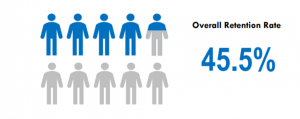Donor churn is the percentage of your donors who choose not to donate again. Donor churn is an important nonprofit metric to measure and take steps to reduce the number of donors who will not make a donation the following year.
According to the 2018 Fundraising Effectiveness Survey Report, The donor retention rate was 45.5 percent in 2017. That is, only 45.5 percent of 2016 donors made repeat gifts to participating nonprofits in 2017.
How would that affect your mission, if only 45.5% of donors made a repeat donation? How much time and effort would it take raise that difference from new donors?

Your organization’s churn rate is directly correlated with your organization’s Donor Retention Rate - the percentage of your donors who return to make another donation. There are several ways to measure churn; however, the most commonly used way to group donors who have “churned” or lapsed in their giving is LYBUNT and SYBUNT.
LYBUNT means donors who have given Last Year But Unfortunately Not This year. This refers specifically to donors who gave in the immediately preceding (last) calendar or fiscal year, but not in the current calendar or fiscal year.
SYBUNT means donors who have given Some Year But Unfortunately Not This year. This refers specifically to donors who gave in any preceding (some) calendar or fiscal year, but not in the currently calendar or fiscal year.
Also key to reducing churn and growing your fundraising efforts is identifying your new donors.
Benefits of Churn Analysis
- Donor Acquisition Costs Are High: Nonprofit professionals focus on donor retention because of the high initial cost of recruiting first-time donors. It can take 18-24 months for nonprofits to recoup the amount of money they spend to attract a first-time donor, as most gifts are generally 2 to 3 times less than the marketing or recruiting cost.
- Gain Access To Bigger Networks With People Fundraising: If you’ve impressed your donor enough to warrant repeat donations, then there’s a chance that donor may be recommending your cause to friends and family—which is the basis of People Fundraising. Thus, that relationship is leveraging additional donations.
- Potential For Larger Gift Amounts: There is a direct correlation between retention and gift size. Returning donors of gifts less than $100 are retained at 53% while retention was 76% for those gifting $250 or more. This could mean that as your nonprofit grows along with your donor, their gifts are likely to increase over time.
Four Ways to Reduce Churn

- Personalize the giving experience: Show your donors how much they matter to you by speaking directly to them. Acknowledge the donor’s interests and communication preferences to tailor your messages to them about donor impact and upcoming engagement opportunities.
- Keep donors informed about why their gift matters: Share nonprofit stories about those impacted by your organization’s work. Include information in your communications that is relevant and useful for your supporters.
- Engage donors with activities: If the constituent is donating, there is something about your cause that resonates with them. Cater personalized engagement opportunities, such as Volunteering, Advocating, or peer to peer fundraising to develop a stronger relationship with the donor.
- Thank your donors immediately and often: Send the donor an immediate donation receipt or a handwritten thank you letter or call the donor to thank them personally. Also, don’t forget to reach out to your donors at other key times of the year - for example, the holidays.
How Can StratusLIVE 365 Help?
The six (6) native churn reports in StratusLIVE 365 empower your organization to perform your very own churn analysis throughout the year or campaign cycle as well as for end of year giving appeals. Additionally, all these reports are Extract reports so that you can take the results directly from the report and immediately take action to retain those donors via a letter, email or phone call appeal. You can also further personalize the donor communications by querying the system to determine the donors’ interests and communication preferences.






